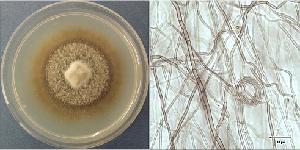
The anamorphic genus Cadophora is an ascomycete group belonging to the diverse order Helotiales. The fungus “Cadophora sp. DSE1049” most probably represents a new species in the genus. The clade where the strain belongs to contains several fungi isolated from the roots of different plant species. According to our present knowledge this Cadophora clade contains so called “dark septate endophytic” (DSE) fungi. This Cadophora group is one of the frequent, common and general members of the DSE community of semi-arid grasslands showing a kind of tendency to non-grass hosts. DSE are found worldwide and comprise a group of root-colonizing endophytic fungi that belong to several ascomycete orders. The DSE fungi seem to have important role in stressful environments and are frequent in semi-arid ecosystems like e.g. the sandy grasslands representing the western-most parts of the Eurasian steppe-belt (the original locality of the strain Cadophora sp. DSE1049) and the prairie ecosystems of North America. The role of the DSEs in the ecosystem functioning is still elusive, their interaction with plants is not as well understood as that of the common mycorrhizae. Moreover, DSE fungi colonize nonmycorrhizal plants, like e.g. the members of mustard family including rapeseed, which is an important biodiesel fuel. We may assume that these root-endophytes represent a special plant-fungus interaction and their comparison with other symbiotic fungi might help us to better understand carbon cycling and ecosystem functioning.
Genome Reference(s)
Knapp DG, Németh JB, Barry K, Hainaut M, Henrissat B, Johnson J, Kuo A, Lim JHP, Lipzen A, Nolan M, Ohm RA, Tamás L, Grigoriev IV, Spatafora JW, Nagy LG, Kovács GM
Comparative genomics provides insights into the lifestyle and reveals functional heterogeneity of dark septate endophytic fungi.
Sci Rep. 2018 Apr 20;8(1):6321. doi: 10.1038/s41598-018-24686-4
